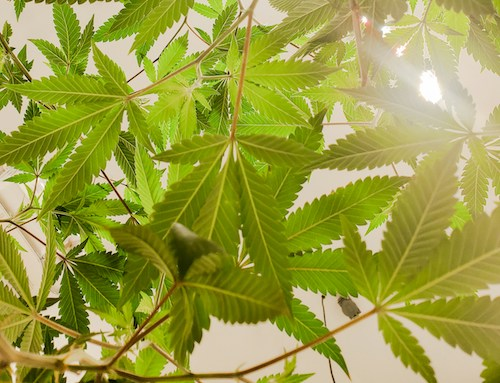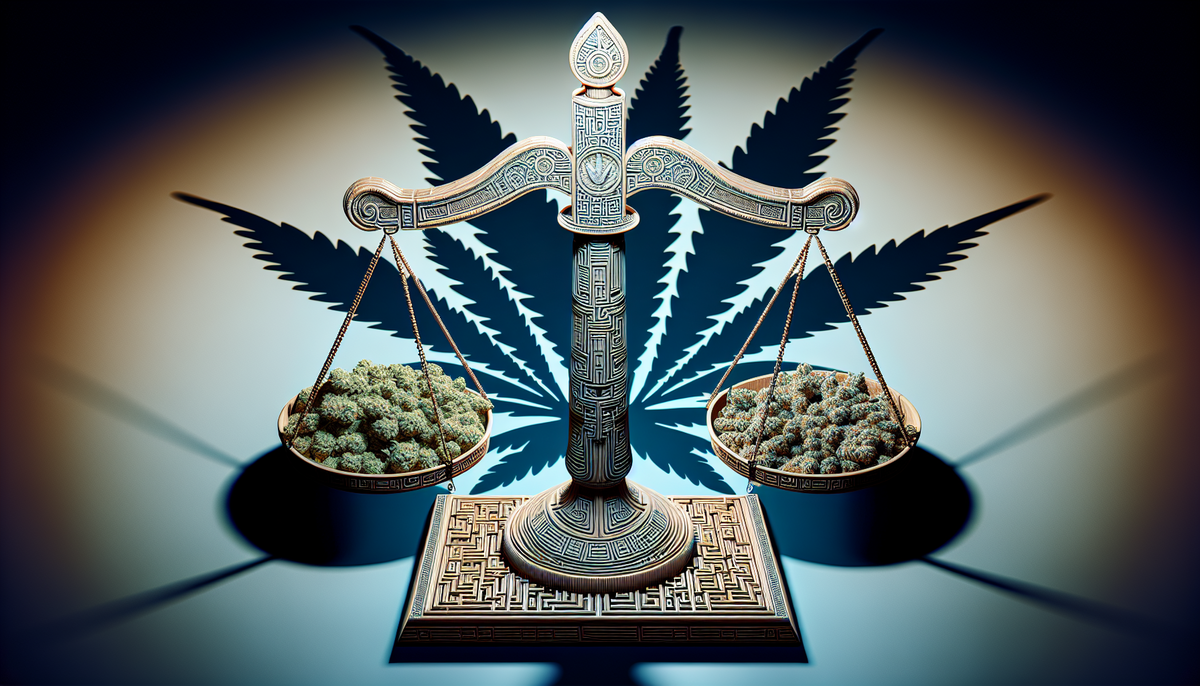The CBD Portal: What is CBD?
Written by: Hunter Podell, Subject Matter Expert and Website Founder
Published: March 15, 2024; Last updated: July 1, 2024
- 1. Key Takeaways
- 2. Understanding CBD: Origins and Components
- 2.1 Cannabis Sativa Plant
- 2.2 Medical Cannabis
- 3. The Science Behind CBD’s Health Benefits
- 3.1 Chronic Pain Relief
- 3.2 Mental Health Support
- 3.3 Seizure Disorders
- 4. Navigating the CBD Market: Products and Quality Control
- 4.1 Types of CBD Products
- 4.2 Third-Party Testing and Certificates of Analysis
- 4.3 Additional Ingredients and Label Transparency
- 5. CBD Legal Aspects and Regulations
- 5.1 Federal Law and the Agriculture Improvement Act
- 5.2 State Laws and Medical/Recreational Use
- 5.3 FDA Approval and Oversight
- 6. Precautions and Potential Risks of CBD Use
- 6.1 Drug Interactions and Other Medications
- 6.2 Pregnancy and Breastfeeding
- 6.3 Long-Term Use and Unexplored Areas
- 7. Summary
- 8. Frequently Asked Questions
- 8.1 What is CBD usually used for?
- 8.2 Is CBD a drug or not?
- 8.3 How does CBD affect you?
- 8.4 What is the best basic CBD info for beginners?
- 8.5 How can I ensure the quality and safety of CBD products?
- 8.6 References
CBD, short for cannabidiol, is a non-intoxicating compound found in the cannabis sativa plant. It’s garnered attention for its potential therapeutic benefits, mainly because it does not produce the ‘high’ associated with THC, another well-known cannabis compound. The exploration of what CBD is, its uses, effects, and legal status has become crucial due to its growing prevalence in various products. This article delves into the science behind its purported health benefits and important considerations for consumers navigating its market and regulations.
Key Takeaways
CBD, derived from the cannabis sativa plant, is prized for its therapeutic potential, and unlike THC, it does not produce psychoactive effects. The legality of its use depends on the THC content and varies by jurisdiction, highlighting the distinction between hemp and non-hemp sources.
Studies suggest CBD may offer health benefits such as pain relief, mental health support, and reduction of seizure frequency in certain epilepsy syndromes. Despite these findings, further research is necessary to confirm its efficacy and long-term safety.
CBD products’ quality, safety, and legality are under strict scrutiny, necessitating third-party testing and accurate labeling to ensure consumer safety. The FDA regulates CBD products and currently approves only Epidiolex for specific seizure disorders, with other uses of CBD remaining unapproved.
Understanding CBD: Origins and Components

CBD, or cannabidiol, is a compound found in the cannabis sativa plant, but it’s not your typical cannabis compound. Unlike THC (tetrahydrocannabinol), which is responsible for the ‘high’ associated with cannabis, CBD does not induce euphoria or impair cognition. This makes CBD a fascinating focus for therapeutic applications, without the psychoactive effects often associated with cannabis.¹
The journey of CBD from plant to product begins with extraction. Various methods, such as:
solvent extraction with ethanol
butane
CO2
other solventless techniques
They are used to extract CBD from the cannabis plant. Furthermore, CBD can come from both hemp and non-hemp varieties of the cannabis sativa plant. The distinction? Hemp contains no more than 0.3% THC, significantly lower than its non-hemp counterparts.²
Cannabis Sativa Plant
Cannabis sativa is a veritable treasure trove of compounds, with CBD and THC being the most well-known. These compounds and others are primarily found in glandular trichomes on the plant’s flowers. What’s intriguing is that the production and stability of cannabinoids like CBD and THC in the cannabis plant are significantly influenced by environmental factors, such as light duration and oxygen levels.
CBD, in particular, has seen a surge in popularity due to its potential therapeutic uses. Unlike THC, it doesn’t provide the psychoactive effects that some people want to avoid. This makes CBD oil a promising option for those seeking the potential benefits of cannabis sativa without the ‘high.’ With the growing interest in CBD, many wonder about its legal status.
Medical Cannabis
Although CBD has recently gained significant attention, we should not forget that it is not the sole therapeutic compound derived from cannabis. The FDA has approved three cannabis-related drug products – Marinol, Syndros, and Cesamet – for therapeutic uses in the United States. What’s unique about these drugs is that they contain synthetic THC, a psychoactive compound.
The approval of these drugs underlines the acknowledged potential of medical marijuana in the medical field. Yet, it doesn’t imply that all cannabis or CBD products have clearance for medical use. Each product must undergo rigorous testing and meet stringent regulations before being considered for medical applications.
The Science Behind CBD’s Health Benefits

The potential health benefits of CBD have sparked widespread interest, leading to numerous claims awaiting scientific confirmation. Preliminary findings from clinical trials have found that treatments containing CBD can improve symptoms such as pain, anxiety, and depression. This contributes to an enhanced overall well-being in patients with moderate to severe conditions.
Today, CBD is promoted as a therapeutic agent for a variety of issues, including:
Anxiety
Insomnia
Pain
PTSD
Depression
Despite these promising potential benefits, we should remember that further research, such as randomized clinical trials, must wholly comprehend and validate these effects.
Chronic Pain Relief
Chronic pain can significantly impair one’s quality of life, making it imperative to find effective treatments for those afflicted. CBD has been proposed to exhibit anti-inflammatory properties and play a role in reducing inflammation and neuropathic pain due to its interaction with the endocannabinoid system. This suggests that CBD could serve as an alternative to opioids and other traditional pain medications, potentially improving the management of chronic pain and enhancing the overall quality of life. ¹
Clinical trials indicate that CBD is promising in reducing pain symptoms associated with multiple sclerosis (M.S.). This potential relief may be due to its ability to modulate anti-inflammatory responses through receptor interaction. Moreover, studies on animals and topical applications suggest that CBD may relieve joint pain and inflammation related to arthritis. These findings point to a promising future for CBD in chronic pain management.
Mental Health Support
Beyond physical conditions, CBD also exhibits potential benefits for mental health. Human studies have shown that CBD can reduce experimentally induced anxiety in both healthy individuals and patients with social anxiety disorder, supporting a general role in anxiety reduction.
CBD interacts with CB1 receptors and 5-HT1A receptors in the brain, which may explain its potential anxiolytic and antidepressant effects. Interestingly, these effects do not appear to escalate with higher doses. Additionally, CBD may enhance fear extinction processes, offering therapeutic potential for post-traumatic stress disorder (PTSD), and has been suggested to have antipsychotic effects, which might be beneficial for schizophrenia and other mental health conditions. ¹
Combined with a strong safety profile, CBD indicates a promising suitability for mental health treatments without common psychoactive drawbacks.
Seizure Disorders
A key advancement in CBD research is its established efficacy in managing severe seizure disorders. Clinical trials have shown CBD to significantly reduce seizures in individuals with Lennox-Gastaut syndrome, Dravet syndrome, and tuberous sclerosis complex. The FDA-approved drug Epidiolex, containing purified CBD, is the only drug approved for treating seizures associated with these conditions. ³
This marks a significant milestone in CBD’s medical applications and provides hope for those suffering from severe epilepsy syndromes. However, as with all medical treatments, it’s crucial to consult with healthcare professionals to determine appropriate dosages and understand potential side effects. Ongoing research aims to shed more light on the long-term impacts of CBD usage on cognitive function and development, particularly in children who suffer from epilepsy.
Navigating the CBD Market: Products and Quality Control

The CBD market has witnessed a dramatic expansion in recent years, providing consumers with a wide range of products. However, with such a saturated market comes the challenge of ensuring product quality and safety. CBD products vary in form and potency, and comprehending these differences is crucial for making knowledgeable decisions.
To ensure the quality and safety of CBD products, third-party testing and Certificate of Analysis (COA) are crucial. These independent verifications can confirm the product’s potency and safety, ensuring that the contents match what the label states and giving consumers confidence in the product’s quality. Let’s delve deeper into understanding the types of CBD products and the importance of quality control.
Types of CBD Products
CBD products can be broadly categorized into three types:
Full-spectrum CBD products: These contain all cannabis plant compounds, including up to 0.3% THC.
Broad-spectrum CBD products: These contain most compounds but have minimal THC content.
Isolates are the purest form of CBD, devoid of other compounds.
These products, including cannabidiol extracts sold online, come in various forms, such as oils, gummies, and topicals like creams and lotions. Oils are used sublingually, topicals are applied to the skin, and gummies are ingestible. The potency of CBD products also varies, with oils offering as low as 5 mg dosages to gummies starting at similar doses.
When choosing CBD products, it’s important to check labels for indications of the type of active ingredient-derived CBD used and look for listed additional ingredients such as carrier oils and flavorings.
Third-Party Testing and Certificates of Analysis
Third-party testing is essential to ensuring CBD products’ quality and safety. Independent tests provide an unbiased report of the product’s ingredients, ensuring that the contents match the label. This is where Certificates of Analysis (COAs) come in. A COA provides detailed information about the contents of CBD products, including the cannabinoid profile and terpene content.
The COA also includes tests for contaminants such as heavy metals, pesticides, and residual solvents, ensuring the product meets safety standards. Consumers can access COAs through links on product pages or by scanning Q.R. codes on product labels, which lead directly to the lab reports online. This transparency allows consumers to avoid products with false labeling and toxic contaminants, ensuring they purchase safe and effective CBD products.
Additional Ingredients and Label Transparency
In addition to CBD content, it’s important to consider additional ingredients in CBD products. For instance, carrier oils such as:
MCT oil
Hemp seed oil
Olive oil
Avocado oil
It might be included and could cause potential allergies. Labels on CBD products should accurately state the total milligrams of CBD and per serving size to ensure proper dosage and address inaccuracies, such as less CBD than labeled or unexpected THC content.
Certificates of Analysis from accredited third-party labs following CLIA and ISO 17025 standards are important for verifying products’ CBD content and purity. Consumers can often find COAs via Q.R. codes or manufacturer websites. Potential contaminants, such as:
pesticides
heavy metals
bacteria
fungus
CBD products could pose risks to consumers, hence the importance of ensuring their safety through rigorous drug test procedures and certification.
This dedication to transparency and quality control is vital in building consumer confidence and guaranteeing product effectiveness.
CBD Legal Aspects and Regulations

Like all products derived from the cannabis plant, the legal aspects and regulations related to CBD can be intricate and diverse. Here are some key points to keep in mind:
The federal law in the U.S. states that CBD derived from hemp is legal, provided it contains 0.3% or less THC by dry weight.
However, the FDA does not allow CBD to be added to food or marketed as a dietary supplement unless it has been approved as safe.
While CBD products are widely available, not all are approved or regulated by the FDA.
Understanding these legal aspects and regulations is fundamental to ensuring the responsible and lawful purchase and use of CBD products. Let’s dive deeper into the legal landscape of CBD, from federal law and the Agriculture Improvement Act to state laws and FDA approval and oversight. ³
Federal Law and the Agriculture Improvement Act
The Agriculture Improvement Act of 2018, commonly referred to as the 2018 Farm Bill, legalized CBD derived from hemp by removing hemp from the Controlled Substances Act in the U.S. This means that under U.S. federal law, hemp is defined as any part of the cannabis sativa plant containing no more than 0.3% THC on a dry weight basis.
However, it’s important to note that despite hemp’s legalization, the FDA maintains authority over hemp products. This means these products must comply with applicable FDA regulations and standards. This dual jurisdiction underscores the need for consumers to be well-informed about the legalities surrounding CBD products.
State Laws and Medical/Recreational Use
While federal law provides a framework for hemp-derived CBD, state laws regarding medical and recreational cannabis use can vary significantly. As of June 2022, medical cannabis use has been legalized in 38 states and Washington, DC, with each state having its regulations regarding qualifying conditions, approved products, and allowances for home cultivation.
In states with legalized medical cannabis, individuals need to be certified by a physician for a qualifying condition and are often required to obtain a license to purchase cannabis. States also vary widely in their medical cannabis possession limits, with some states allowing as little as 1.5 grams and others as much as 762.05 grams of pure THC over 30 days. For full-spectrum CBD products, it’s critical to check the THC content on the label to ensure it adheres to individual needs and state-specific legal thresholds.
You can learn more about individual state laws in our interactive map section.
FDA Approval and Oversight
The FDA plays a crucial role in the regulation of CBD products. Currently, the only FDA-approved medicine containing CBD is Epidiolex, which is used to treat seizures associated with Lennox-Gastaut syndrome, Dravet syndrome, and tuberous sclerosis complex.
The FDA regulates CBD products under the Federal Food, Drug, and Cosmetic Act and has issued warnings to companies selling CBD with false therapeutic claims. It has also stated that CBD products are not permitted as dietary supplements. The FDA is exploring whether to create additional regulatory pathways for hemp-derived products, including CBD, beyond existing drug, cosmetic, and food regulations.
The FDA’s support for scientifically-based research into the medicinal uses of cannabis, as well as the fact that the FDA approves certain CBD-based medications, is a promising step towards understanding and utilizing the full potential of CBD.
Precautions and Potential Risks of CBD Use

Despite the promising potential benefits of CBD, it is important to be aware of the precautions and potential hazards linked to its use. Aside from Epidiolex, other CBD products and uses have not been FDA-approved, highlighting the uncertainty regarding their safety and efficacy. Potential side effects can include:
Suicidal thoughts or behaviors
Sleepiness
Drowsiness
Diarrhea
Loss of appetite
Potential liver damage
In some cases, there is a risk of an increase in seizures, particularly when the CBD product used may be contaminated with THC.
Before using any CBD products for health concerns, it is important to:
Consult a medical professional and verify that the chosen products clearly label the CBD content and other ingredients.
Understand the potential drug interactions.
Be aware of the effects on pregnancy and breastfeeding.
Consider the long-term effects of CBD use.
By following these guidelines, consumers can make informed decisions and use CBD safely and effectively.
Drug Interactions and Other Medications
CBD may interact with specific medications, influencing their effectiveness and side effects. For example, CBD can interact with certain antiepileptic drugs, possibly enhancing their effects or leading to other interactions. CBD might also alter the effects and side effects of medications changed by the liver by changing the speed of their breakdown.
Furthermore, CBD might interact with CNS depressants, potentially causing an increase in sleepiness or slower breathing. With these potential interactions, it’s crucial to consult a healthcare provider before using CBD, especially if you’re on other medications. Informing your doctor about your CBD use can help prevent any adverse effects and ensure that your other medications continue to work effectively.³
Pregnancy and Breastfeeding
Using CBD during pregnancy or breastfeeding is generally not recommended. Chemicals from marijuana, including CBD, can be passed from a mother to her infant through breast milk, potentially affecting the infant’s neurodevelopmental processes. Moreover, it may be unsafe to take CBD during these times due to the potential for contamination with other ingredients that could be harmful to the fetus or infant. ³
Given these potential risks and the lack of sufficient data, it’s recommended that mothers who use marijuana in any form, including CBD, should not breastfeed. This reinforces the need for further research and consultation with healthcare professionals when considering CBD use during pregnancy or breastfeeding.
Long-Term Use and Unexplored Areas
Many aspects of the long-term effects and safety profile of CBD use remain unknown. High daily doses of CBD have been connected with serum enzyme elevations, an indicator of potential liver injury, although there has been no strong association with clinically evident liver injury and jaundice. Furthermore, chronic CBD exposure may lead to reproductive toxicity in males by affecting sperm quality.
More comprehensive clinical trials and scientific studies are needed to establish safe guidelines for long-term CBD use. As we continue to explore the potential benefits of CBD, it’s crucial to focus on the potential risks and ensure that CBD use is safe and beneficial for all consumers in the long term.
Summary
We’ve journeyed from the origins of CBD to the intricacies of the CBD market, explored its potential health benefits, and delved into the legal aspects and regulations surrounding its use. We’ve also examined the precautions and potential risks associated with CBD use. As the CBD landscape evolves, staying informed about the latest research, regulations, and product quality is essential. Remember to consult with healthcare professionals before starting any CBD regimen and choose products that are independently tested and certified for quality and safety. Enjoy the journey of discovery, and here’s to your health and wellness!
Frequently Asked Questions
What is CBD usually used for?
CBD is usually used for managing symptoms related to anxiety, chronic pain, inflammation, and insomnia. It’s important to consult with a healthcare provider for personalized advice on CBD use.
Is CBD a drug or not?
CBD is considered a drug because it is FDA-approved as a medication, and its use in food and dietary supplements is restricted under current regulations.
How does CBD affect you?
CBD can cause side effects such as dry mouth, low blood pressure, lightheadedness, and drowsiness. It is important to note that signs of liver injury have been reported with high doses of prescription CBD. Overall, while generally well tolerated, CBD use also carries some risks, including potential interactions with other medications.
What is the best basic CBD info for beginners?
CBD is a non-psychoactive compound found in marijuana, derived from hemp, with low THC levels. It interacts with the body’s endocannabinoid system and is known for its potential benefits in regulating pain, inflammation, moods, sleep, and appetite.
How can I ensure the quality and safety of CBD products?
To ensure the quality and safety of CBD products, look for those that have been independently tested and come with a Certificate of Analysis (COA). This will guarantee that the products meet safety and quality standards.
References
Rapin, L., Gamaoun, R., El Hage, C., Arboleda, M. F., & Prosk, E. (2021). Cannabidiol use and effectiveness: real-world evidence from a Canadian medical cannabis clinic. Journal of cannabis research, 3(1), 19. https://doi.org/10.1186/s42238-021-00078-w
Lazarjani, M. P., Young, O., Kebede, L., & Seyfoddin, A. (2021). Processing and extraction methods of medicinal cannabis: a narrative review. Journal of cannabis research, 3(1), 32. https://doi.org/10.1186/s42238-021-00087-9
Centers for Disease Control and Prevention. (2022a, August 8). CBD: What you need to know. Centers for Disease Control and Prevention. https://www.cdc.gov/marijuana/featured-topics/CBD.html

Written by Hunter Podell - Subject Matter Expert and Website Founder
Hunter has 8+ years of experience as a content writer and digital marketer. Earning his chops marketing in the healthcare space for over 5 years, Hunter is extremely familiar with the rules and regulations required to deliver high quality content that answers the user's needs while adhering to strict guidelines.
Join the CBDeals Club!
Get 10% off your first order and receive our best and exclusive promotions directly to your inbox!



